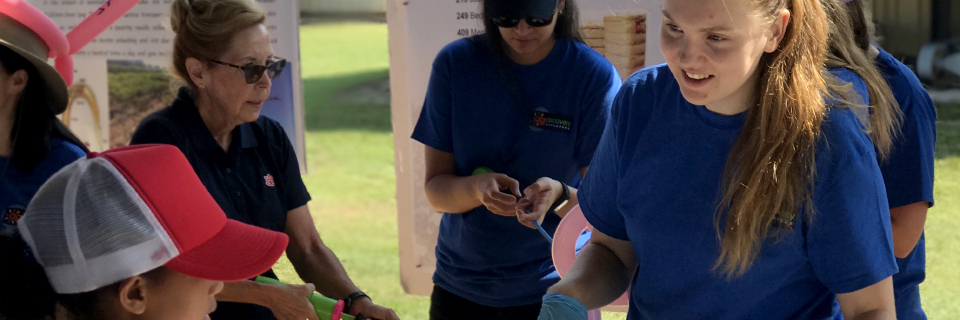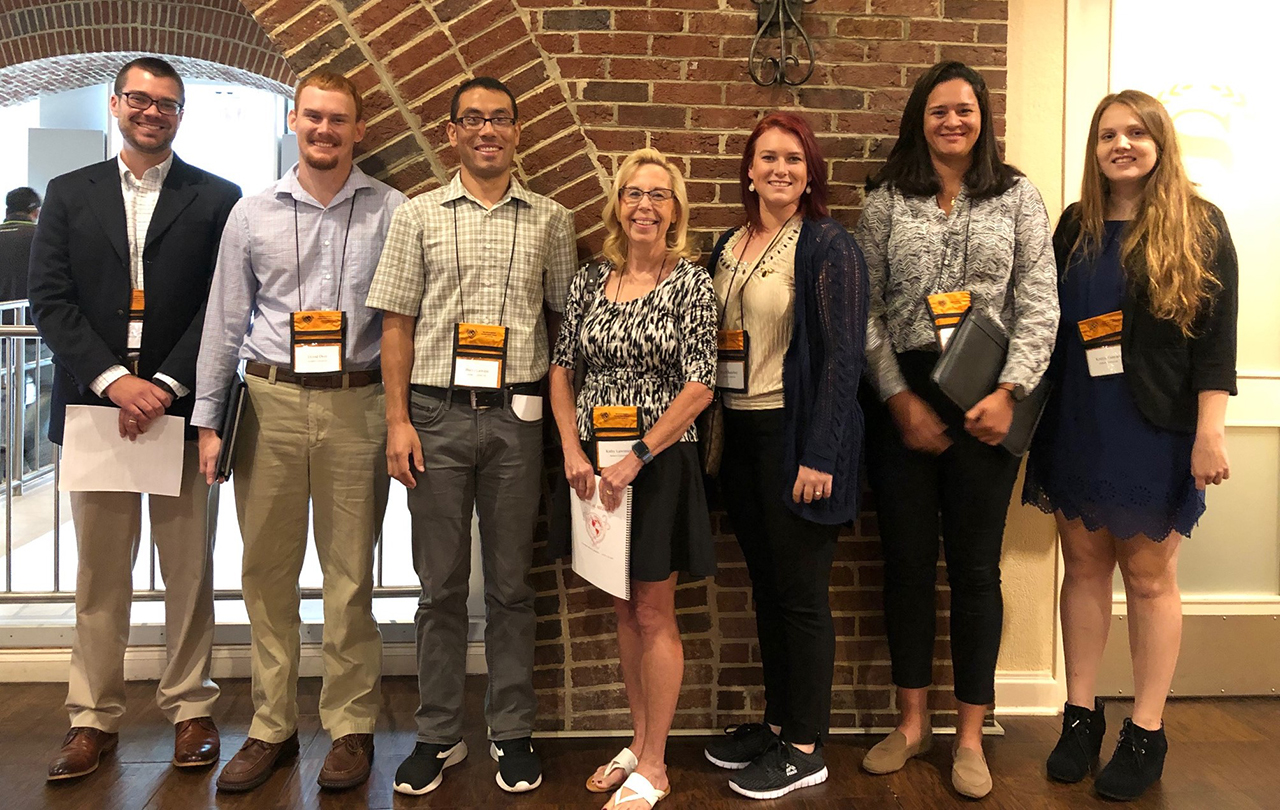Dr. Lawrence’s Lab
Current Graduate Students
- Claire Schloemer – M. S. Student, Entomology. Thesis: Evaluation of organic amendments and cover crops on insects and nematodes in Sweet Potato production.
- Drew Schrimsher – PhD. Student. Plant Pathology. Dissertation: Cotton cultivar response to Meloidogyne incognita.
Completed Dissertation & Thesis
William Groover – Ph.D. Plant Pathology, Dissertation: Evaluation of UAS equipped with multispectral cameras as a diagnostic tool for soil-borne diseases in warm-season grasses.
- Current position: Regional Agronomist BASF South Carolina and East Georgia.
David Dyer – Ph.D. Plant Pathology, Dissertation: Evaluating the presence of Fusarium oxysporum f. sp. vasinfectum races throughout a cotton growing season.
- Current position: Corteva CPD&D North American Field Scientist at the Florida Research Center in Myakka City, Florida.
Marina Nunes Rondon – Ph.D. Plant Pathology, Dissertation: Investigation of the Corynespora cassiicola pathogen and its interaction with soybean.
- Current position: Syngenta Seeds Plant Pathologists Scientist Uberlandia, MG, Brazil.
Kate Armstrong – M.S. Plant Pathology, Thesis: Evaluation of Meloidogyne incognita and Rotylenchulus reniformis nematode resistant cotton cultivars with supplemental Corteva Agriscience nematicides.
- Current position: PhD. Student at the University of Tennessee, Knoxville, TN.
Kara Gordon – M.S. Plant Pathology, Thesis Management of Rotylenchulus reniformis and Meloidogyne incognita on Gossypium hirsutum in Alabama and the economic impact of additional fertilizer and nematicide applications.
- Current position: Rice Tech. Research Scientist Houston, TX
WinDi Sanchez – M.S., Plant Pathology, Thesis: Entomopathogenic nematodes as part of an integrated pest management program for control of small hive beetles (Aethina tumida)
Kaitlin Gattoni – M.S. Student, Plant Pathology, Thesis: Systemic induced resistance to M. incognita by Bacillus spp.
- Current Position: Ph.D. candidate Department of Plant Pathology. University of Florida
- Accomplishments: Has presented 3 conference oral presentations; Published 2 conference papers; and won first place as “Outstanding Graduate Student Presentation” at the Beltwide Cotton Conference, San Antonio, Texas, 2018 and first place as “Outstanding Graduate Student Presentation” at the Southern Soybean Disease Workers Conference, Panama City, Florida, 2019.
Ni Xiang – Ph.D. Student, Plant Pathology, Graduated Fall 2016, Dissertation: Biological control of Bacillus spp. on Root-knot and Soybean Cyst nematode
- Current Position: Nematologist, Bayer Crop Science, ST. Louis , MO
- Accomplishments: Has presented 4 conference oral presentations or posters; Published 1 refereed journal article; 6 peer-reviewed papers; and 3 conference papers. 2016 International Student award, Auburn University; 2016 Graduate Travel Fellowship, Auburn University; 2015 Graduate Travel Fellowship, Auburn University; and 2013-2014 Outstanding Ph.D. Student Award, Entomology & Plant Pathology, Auburn University.
Daniel Dodge – M.S. Student, Plant Pathology, Graduated: Spring 2017, Thesis: Development of an integrated pest management program for Root knot nematode management is soybeans in Alabama utilizing plant hormones, starter fertilizers, and nematicides.
- Current Position: Nematologist Valent BioSciences, Libertyville, IL
- Accomplishments: Has presented 2 conference oral presentations or posters; Published 1 Peer-reviewed papers and 1 conference paper.
Stephen Till – M.S. Student, Plant Pathology, Graduated: Fall 2017, Thesis: An integrated approach to improving corn plant health in Meloidogyne incognita infested fields with nematicides, plant growth regulators, and starter fertilizers.
- Current Position: AGRI-AFC Agronomist &Technology Manager for South Alabama, Florida and South Mississippi located in Headland, Alabama.
- Accomplishments: Has presented 2 conference oral presentations or posters; Published 1 Peer-reviewed papers and 1 conference paper.
Meredith Hall – M.S. Student, Plant Pathology, Graduated: Summer 2017, Thesis: Root-knot nematode (Meloidogyne incognita) and fungal susceptibility of turmeric (Curcuma spp.) selections.
- Accomplishments: Has presented 2 conference oral presentations or posters; Won “Outstand Graduate Student Poster Presentation” in the graduate student presentation contest at the Society of Nematology Meeting of the Americas in Montreal, Canada in July 2016.
Justin Luangkhot – M.S. Student, Plant Pathology, Graduated: Spring 2016, Thesis: Development of an integrated pest management program for plant parasitic nematode control on cotton in Alabama utilizing plant hormones, starter fertilizers, and nematicides.
- Current Position: Research and Development with Wilbur Ellis located in Kennewick, WA.
- Accomplishments: Presented 8 conference oral or poster presentations; Published 4 Peer-reviewed papers and 2 conference papers. Awarded the Outstanding MS Student in the Department of Entomology and Plant Pathology, Auburn University 2014-2015.
Caroline Land – M.S. Student, Plant Pathology, Graduated: Summer 2015, Thesis: The study of applied management options to enhance crop protection against Verticillium wilt in Gossypium hirsutum.
- Current Position: Research and Development Scientist with Syngenta Crop Protection Katy, TX
- Accomplishments: Presented 4 conference oral presentations or posters; Published 9 Peer-reviewed papers; and 1 conference paper. Awarded the Outstanding MS Student in the Department of Entomology and Plant Pathology, Auburn University 2013- 2014. Won “First Place” and “Second Place” in the graduate student presentation contest at the Beltwide Cotton Conferences in 2014 and 2015.
Amber Smith – M.S. Student, Plant Pathology, Graduated: Spring 2015, Thesis: Cotton Cultivar Response to the Fusarium Wilt Root-knot Nematode Disease Complex and the Identification of Fusarium oxysporum f. sp. vasinfectum Races in Alabama.
- Current Position: Research Scientist – Plant Pathologist and Nematologist with Hubbard Agricultural Science located in Kennewick, WA.
- Accomplishments: Presented 4 conference oral presentations or posters; Published 2 Peer-reviewed papers; and 2 conference paper. Won “Second Place”and “First Place” in the graduate student presentation contest at the Beltwide Cotton Conferences in 2014 and 2015.
David Bailey – M.S. Student, Plant Pathology, Graduated: Summer 2014
- Current Position: CPS Agricultural Technology Specialist in North Alabama and Central Tennessee located in Huntsvilles, Alabama.
- Accomplishments: Presented 2 conference papers; Published 10 Peer-reviewed papers.
Drew Schrimsher – M.S. Student, Plant Pathology, Graduated: Summer 2013., Thesis: The Studies of Plant Host Resistance to the Reniform Nematode in Upland Cotton and the Effects of Bacillus firmus GB-126 on Plant-Parasitic Nematodes.
- Current Position: AGRI-AFC Agronomist &Technology Manager for South Alabama, Flordia and South Mississippi located in Slocomb, Alabama.
- Accomplishments: Presented 5 conference papers; Publishing 1 paper from thesis; Published 10 Peer-reviewed papers; Awarded the Outstanding MS Student in the Department of Entomology and Plant Pathology, Auburn University 2011- 2012.
Scott R. Moore – Ph.D. Student, Plant Pathology, Graduated: Summer 2012, Dissertation: Evaluation of the Interactions of Soil Edaphic Characteristics and nematicides with Rotylenchulus reniformis and Developing Models for Prescription Management in Cotton.
- Current Position: Syngenta Research and Development Scientist II, Biological Assessment- North America Product Evaluation located in Monroe, LA.
- Accomplishments: Presented 9 conference papers; Publishing 4 papers from dissertation; Published 42 Peer-reviewed papers; Awarded the 2012 Competitive Monetary Award for Excellence in Graduate Research, Alabama Cotton Commission; Awarded the 2012 Cotton Disease Council Graduate Student Paper Competition, 1st Place; Awarded the 2010 Society of Nematologists Student Paper Competition, 2nd Place; Awarded the Outstanding PhD Student in the Department of Entomology and Plant Pathology, Auburn University 2010-2011.
Juan David Castillo – Ph.D. Student, Plant Pathology, Graduated: Fall 2012, Dissertation: Biocontrol of the Reniform nematode (Rotylenchulus reniformis) with the fungi Paecilomyces lilacinus and the bacterium Bacillus firmus, and mix of PGPR strains on Cotton crops in Alabama.
- Current Position: Biointeractions and Plant Health, Wageninger UR, located in the Netherlands.
- Accomplishments: Presented 5 conference papers; Published 1 book chapter; Publishing 4 papers from dissertation; Published 6 Peer-reviewed papers; Awarded the 2012 Nathan A. Cobb Nematology Foundation John M. Webster Outstanding Student Award
Tamara Z. Scott – M.S. Student, Plant Pathology, Graduated: Summer 2012, Thesis: Cultivar Susceptibility to the Fusarium Wilt Complex and Race Characterization of Fusarium oxysporum f. sp. vasinfectum.
- Current Position: MD Anderson Hospital Histology Technician located at Houston TX.
- Accomplishments: Presented 2 conference papers; Publishing 1 papers from her thesis; Published 6 Peer-reviewed papers
Dustin M. Herring – M.S. Student, Plant Pathology, Graduated: Summer 2011
- Current Position: Monsanto Farm Research Associate located at the FTS Farm Winterville, MS.
- Accomplishments: Presented 2 conference papers; Published 5 Peer-reviewed papers; Awarded the 2010 Cotton Disease Council Graduate Student Paper Competition 1st Place; Awarded a 2010 Bayer Crop Science Summer internship; Awarded the Outstanding M. S. Student in the Department of Entomology and Plant Pathology, Auburn University 2009-2010; Department of Entomology and Plant Pathology Graduate Student Council representative 2009 – 2010
Scott R. Moore – M.S. Student, Plant Pathology, Graduated: Fall 2009, Thesis: Dimensional Movement of Rotylenchulus reniformis.
- Accomplishments: Presented 6 conference papers; Published 2 papers from his thesis; Published 37 Peer-reviewed papers; Awarded the 2009 Dow Agro Sciences Travel Award, Society of Nematologists; Awarded the 2009 Cotton Disease Council Graduate Student Paper Competition Top 3; Department of Entomology and Plant Pathology Graduate Student Council representative 2008 – 2009. Awarded the 2008 – 2009 Outstanding Master’s Student, Auburn University Dept. of Entomology and Plant Pathology.
Juan David Castillo – M.S. Student, Plant Pathology, Graduated: Fall 2009, Thesis: Identification of Nematode Species by FAME Analysis.
- Current Position: Syngenta Research and Development Scientist I located in Gainesville, FL.
- Accomplishments: Presented 10 conference papers; Published 2 papers from his thesis; Published 17 Peer-reviewed papers Awarded Second Place in the American Phytopathological Society Southern Division Graduate Student Competition, February 2009; Awarded First Place in the Cotton Disease Council Graduate Student Competition, January, 2009; Awarded the Outstanding Masters Graduate Student in Plant Pathology, May 2008; Awarded First Place in the Auburn University Graduate Student Forum, Science Category, March 2008.
Taylor B. Hatchet – M.S. Student, Plant Pathology, Graduated: Spring 2009, Thesis: urvey of the biological activity of 7,10,12-trihydroxy-8-octadecenoic acid (TOD) from Pseudomonas aeruginosa and its potential use to control Magnaporthe grisea and other plant pathogenic fungi.
- Current Position: Co-Owner of Hatchet Farms, Jamison, Alabama.
- Accomplishments: Presented 3 conference papers; Published 4 Peer-reviewed papers; Awarded the Outstanding Masters Graduate Student in Plant Pathology, May 2007.
Amy Dismuckes – M.S. Student, Plant Pathology, Graduated: Summer 2008
- Current Position: Horticulutre expension agent, Georgia
Stan R. Usery – M.S. Student, Plant Pathology,Graduated: Spring 2005, Thesis: Rotylenchulus reniformis tolerant and/or resistant cotton varieties.
- Current Position: Co-owner of Usery Farms, and owner of Usery Nematode services in Elkmont, Alabama.
- Accomplishments: Presented 4 conference papers; Published 1 paper from his thesis; Published 17 Peer-reviewed papers; Awarded the Outstanding Masters Graduate Student in Plant Pathology, May 2005
Jarrod R. Jones – M.S. Student, Plant Pathology, Graduated:Summer 2004, Thesis: Cotton production utilizing winter cover crops for disease suppression and enhanced soil health.
- Current Position: Assistant Director of the Gulf Coast Research Center, Auburn University.
- Accomplishments: Presented 2 conference papers; Published 2 paper from his thesis; Published 17 Peer-reviewed papers; Awarded the Outstanding Masters Graduate Student in Plant Pathology, May 2004.
Nicholas W. Greer – M.S. Student, Plant Pathology, Graduated: Summer 2004
- Current Position: Aphis, Shreveport, LA.
Aaron J. Palmateer – Ph.D. Student, Plant Pathology, Graduated:Summer 2003, Dissertation: Mycoflora relations and interactions with Rotylenchulus reniformis on cotton.
- Accomplishments: Pres
Scott R. Moore – M.S. Student, Plant Pathology, Graduated: Fall 2009, Thesis: Dimensional Movement of Rotylenchulus reniformis.
- Current Position: Associate Professor & Extension Specialist, Ornamental Plant Pathology, Tropical Research & Education Center of the University of Florida.
- Accomplishments: Presented 4 conference papers; Published 4 papers from his dissertation; Published 57 Peer-reviewed papers; Awarded the competitive Auburn University Harry Merriwether Fellowship (2000-2003) monetary award of $4000; Awarded the Auburn University Graduate Student Research Award May 2003; Awarded the Outstanding Ph.D. student in the Department of Entomology & Plant Pathology at Auburn University May 2003; Awarded the Southern Division American Phytopathological Society travel award of $1000.
Graduate Students Advised As Committee Members
M.S. 2012
Department of Entomology and Plant Pathology
M.S. 2012
Department of Entomology and Plant Pathology
M.S. 2011
Agronomy and Soils Department
M.S. 2011
Agronomy and Soils Department
Ph.D. 2010
Dept. of Entomology and Plant Pathology
2010
Dept. of Entomology and Plant Pathology
2010
Dept. of Entomology and Plant Pathology
Ph.D. 2010
Integrated Forest Pathology/Entomology
M.S. 2010
Department of Plant and Soil Science
Alabama A&M University
M.S. 2010
Department of Plant and Soil Science
Alabama A&M University
M.S. 2010
Department of Plant and Soil Science
Alabama A&M University
Ph.D. 2009
Department of Plant and Soil Science
Alabama A&M University
M.S. 2009
Department of Plant and Soil Science
Alabama A&M University
Ph.D. 2009
Dept. of Entomology and Plant Pathology
Auburn University
M.S. 2009
Microbiology Department
Auburn University
M.S. 2009
Dept. of Entomology and Plant Pathology
Auburn University
M.S. 2008
Dept. of Entomology and Plant Pathology
Auburn University
M.S. 2008
Dept. of Entomology and Plant Pathology
Auburn University
Ph.D. 2005
Dept. of Entomology and Plant Patholog
Ph.D. 2004
Dept. of Entomology and Plant Pathology.
Ph.D. 2002
Dept. of Entomology and Plant Pathology
Ph.D. 2002
Dept. of Entomology and Plant Pathology
M.S. 2002
Dept. of Entomology and Plant Pathology



